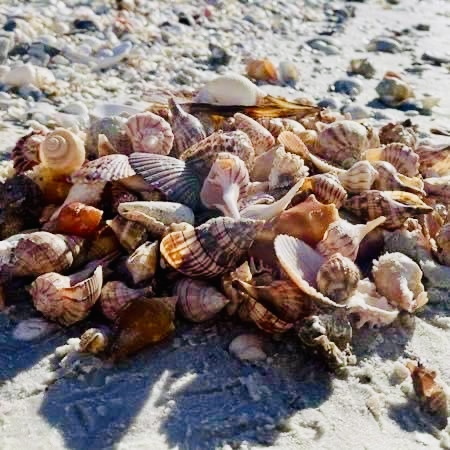Florida’s beaches are world-renowned for their natural beauty and abundance of seashells. From the delicate Junonia to the colorful Calico Scallop, countless treasures await curious beachcombers. This guide will introduce you to some of the most common and sought-after seashells found on Florida’s shores, including those on Marco Island, Sanibel Island, and the secluded islands within the Ten Thousand Islands National Wildlife Refuge, like Kice Island and Dickmans Island.
Where to Go Shelling in Florida
Florida Seashell Identification Guide
Where to Go Shelling in Florida
Shelling is a timeless activity enjoyed by visitors and residents alike. Whether you’re an experienced collector or just starting out, Florida’s beaches offer something for everyone. Here are some of the best shelling destinations in the state:
Sanibel Island
This barrier island is legendary for its shelling opportunities. Shells from the Gulf of Mexico and the Atlantic Ocean converge on Sanibel’s shores, making it a haven for shell collectors.
Marco Island
Accessible by causeway, Marco Island offers a variety of shelling locations. From the beaches directly on the island to those accessible by boat tours, Marco Island boasts abundant shelling grounds.
Ten Thousand Islands National Wildlife Refuge
This remote archipelago offers some of the most pristine shelling in Florida. Kice Island and Dickmans Island are just two of the many islands within the refuge that are known for their shelling treasures. However, these islands can only be reached by boat.
Tips for Finding Shells
-
- Look after Low Tide: Low tide exposes more of the beach, revealing shells that may be hidden underwater during high tide.
-
- Explore Different Areas: Shelling success varies depending on location. Walk along the shoreline, sandbars, and near inlets for the greatest chance to find shells.
-
- Turn Over Rocks and Seaweed: Many shells become lodged under rocks and seaweed. Gently examine these areas to uncover hidden treasures.
-
- Consider a Guided Tour: An experienced guide can lead you to the best shelling spots and help you identify your finds.
Types of Seashells
Seashells come in a wide variety of shapes, sizes, and colors. Here’s a basic breakdown of the two main types:
Bivalve Shells: Nature’s Clamshell Treasures
Bivalve shells, also known as clamshells or pectin shells, are a fascinating group of seashells found in oceans, lakes, and rivers worldwide. These mollusks boast two hinged valves that perfectly enclose the soft body within. Unlike single-piece gastropod shells (like whelks or conchs), bivalve shells are defined by their two interlocking parts.
Common Bivalves on Florida’s Beaches
-
- Clams: Clams are the quintessential bivalve, and their smooth, rounded shells come in a variety of colors and sizes.
-
- Cockles: These heart-shaped bivalves have ribbed or ridged shells and can be quite large.
-
- Scallops: Scallops are distinctive for their fan-shaped shells with radiating ribs. They are prized not only for their beauty but also for their delicious meat.
Finding Bivalve Shells
-
- Low Tide: Low tide exposes more of the beach, revealing bivalve shells that may be hidden underwater during high tide.
-
- Sandy Areas: Bivalves often burrow in the sand, so keep your eyes peeled as you walk along the shoreline.
-
- Seagrass Beds: Some bivalve species live amongst seagrass beds. Look for shell fragments or slightly open shells peeking out from the grass.
The Beauty of Bivalve Shells
Bivalve shells come in a surprising array of colors, patterns, and textures. From the smooth sheen of clams to the ribbed detail of cockles, each shell is a unique work of art. These wonders of the sea are not only beautiful to collect and admire but also a reminder of the incredible biodiversity of our oceans.
Unveiling the Wonders of Gastropod Shells: Florida’s Uniquely Shaped Treasures
While bivalve shells boast two halves, gastropod shells are single, complete homes for fascinating creatures like snails. These gastropod wonders, also known as univalve shells, come in a captivating array of shapes, sizes, and colors, making them prized possessions for shell collectors and nature enthusiasts alike.
Common Gastropod Shells Found in Florida
-
- Conch Shells: These large, majestic gastropod shells are instantly recognizable by their flared lip and two prominent points. They come in a variety of colors and patterns.
-
- Whelks: Whelk shells boast a more elongated shape with a pointed spire at the top. Their thick walls often feature ridges or bumps.
-
- Lightning Whelks: The state shell of Texas, Lightning Whelks can also be found on Florida’s shores. These impressive shells can grow quite large and are known for their distinctive spiral ridges that resemble lightning bolts.
Exploring Gastropod Shell Shapes
The world of gastropod shells offers a diverse range of shapes:
-
- Oblong: These elongated shells are often slender and tapered, resembling a tube or a pointed oval.
-
- Globose: These round and bulbous shells are reminiscent of spheres or marbles.
-
- Depressed: These gastropod shells have a flattened appearance, like a round disc or a slightly squashed sphere.
Tips for Finding Gastropod Shells
-
- Look for Shells After Storms: Storms can stir up the seabed, unearthing hidden gastropod shells and bringing them closer to shore.
-
- Explore Rocky Areas: Certain gastropod species cling to rocks for protection. Carefully examine rocky areas and tide pools for these unique shells.
-
- Consider Guided Tours: Experienced guides can lead you to prime gastropod habitats and share their knowledge of these fascinating mollusks.
The Enduring Beauty of Gastropod Shells
From the majestic conch to the intricately patterned whelk, gastropod shells are a testament to nature’s artistry. Their unique shapes, vibrant colors, and intricate details make them captivating collectibles and a reminder of the incredible biodiversity of our oceans.
Florida Seashell Identification Guide
Now that you’re familiar with the basics of shelling, let’s explore some of the unique seashells you might find on Florida’s beaches:
Calico Scallop Shells
These fan-shaped bivalve shells, known as Calico Scallops (Argopecten gibbus), come in a diverse assortment of colors and patterns. They can be distinguished by their radial fluted ridges. They are brightly colored, and no two Calico Scallops look alike!
Ceriths Shells
Ceriths shells (Cerithium genus) are small gastropod shells, rarely larger than an inch in size. They are narrow, spired shells, often with a brown striping pattern. They are also known as horned shells.
Cockle Shells
A cockle shell (Cardiidae family) is a bivalve shell and one of the most common finds on Florida beaches. They can be confused for scallop shells but are actually home to a unique mollusk called a cockle. A true cockle has a heart-shaped shell that is rounded on the top. These common shells can grow to be fairly big, and a large, intact cockle shell is an exciting find for any collector!
Conch Shells
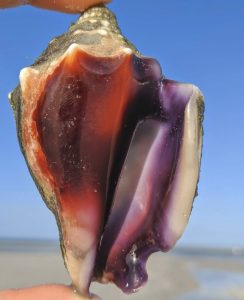 The Conch (Strombus gigas) is another rare and beautiful gastropod shell found in Florida. Conch shells are medium to large in size and can be identified by their two distinct points. It is difficult to identify a shell by color, as they tend to be unique. The Conch shell is home to a variety of different sea snails. Conchs are a little more ambiguous, as the word “conch” itself comes from the Latin and Greek for “shellfish.”
The Conch (Strombus gigas) is another rare and beautiful gastropod shell found in Florida. Conch shells are medium to large in size and can be identified by their two distinct points. It is difficult to identify a shell by color, as they tend to be unique. The Conch shell is home to a variety of different sea snails. Conchs are a little more ambiguous, as the word “conch” itself comes from the Latin and Greek for “shellfish.”
Coquinas Shells
Coquinas shells (Donax variabilis) are tiny bivalve shells that come in a wide range of colors and patterns. Most coquinas shells are no bigger than a dime! You need to be careful when gathering these shells, as their size makes them more likely to wash up on shore alive. Coquinas shells can be blue, pink, purple, orange, brown, or some combination. It’s their unique coloration that makes these little shells such treasures.
Florida Spiny Jewelbox Shells
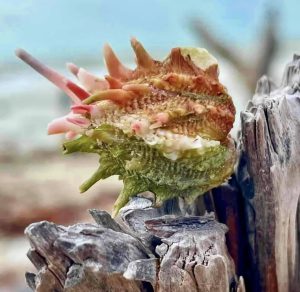
The Florida Spiny Jewelbox (Arcinella cornuta) is a bivalve shell that is home to a clam. It is a thick, heavy, white shell with a pink or red interior that can be identified by its rows of pleated ribs. These shells are predominantly found along Florida’s coast. They make their home in the local coral reefs. You are unlikely to find this unique shell anywhere else in the world!
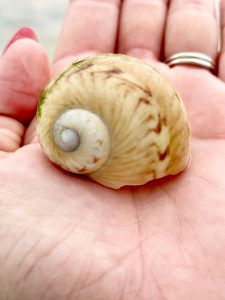 Gaudy Nautica (Naticarius canrena, also known as Natica canrena): Also known as moon snails, these medium to large gastropod shells are known for their smooth, glossy surface and wide, circular aperture (opening). They typically exhibit a range of colors and patterns, including bands, stripes, or splotches, which can vary significantly among individual shells. The overall shape is globular and somewhat flattened, and they are often admired for their aesthetically pleasing appearance. They commonly display a variety of hues, including shades of brown, tan, white, and occasionally hints of blue or purple. The patterns can include concentric bands or irregular spots, giving each shell a unique look.
Gaudy Nautica (Naticarius canrena, also known as Natica canrena): Also known as moon snails, these medium to large gastropod shells are known for their smooth, glossy surface and wide, circular aperture (opening). They typically exhibit a range of colors and patterns, including bands, stripes, or splotches, which can vary significantly among individual shells. The overall shape is globular and somewhat flattened, and they are often admired for their aesthetically pleasing appearance. They commonly display a variety of hues, including shades of brown, tan, white, and occasionally hints of blue or purple. The patterns can include concentric bands or irregular spots, giving each shell a unique look.
Horse Conch: Florida’s State Shell!
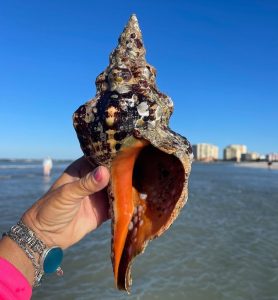
Horse Conch (Pleuroploca gigantea): This large and impressive gastropod shell is a prized find for collectors. Easily distinguished by its elongated shape and flared lip, the Horse Conch can reach lengths of up to 18 inches! These shells come in a variety of colors, including orange, brown, and yellow, and often have a glossy finish. The name “Horse Conch” comes from the resemblance of its flared lip to the flared nostrils of a horse.
Jingle Shells
It’s easy to distinguish a jingle shell (Anomia simplex) by its paper-like translucence. Jingle shells are named for the sound they make when shaken and come in a range of colors. They tend to have a wrinkled texture and a pleasant, almost polished sheen. Because of the way they look, they are sometimes known as “Mermaid’s toenails.”
Junonia Shells
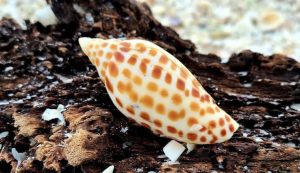
Junonia shells (Scaphella junonia) are some of the rarest types of shells in Florida, but they’re out there! When identifying seashells that you think might be Junonia, look for an off-white, oblong gastropod shell with brown spots that look like watercolor paint. This shell houses a yellow, spotted snail that you are unlikely to find anywhere else in the world
King’s Crown Conch Shells
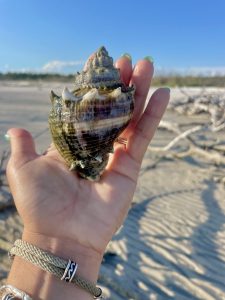 The King’s Crown (Melongena corona) is a big and beautiful gastropod shell. Most King’s Crown shells will be three to four inches in length. These shells can be yellow, brown, or red. King’s Crowns have long, narrow spires, with the opening on the right-hand side. These unique shells are quite common in Florida. They are so-named because their texture resembles the pleated look of a crown.
The King’s Crown (Melongena corona) is a big and beautiful gastropod shell. Most King’s Crown shells will be three to four inches in length. These shells can be yellow, brown, or red. King’s Crowns have long, narrow spires, with the opening on the right-hand side. These unique shells are quite common in Florida. They are so-named because their texture resembles the pleated look of a crown.
Lightning Whelk Shells
The Lightning Whelk (Busycon sinistrum) is indeed a fascinating gastropod mollusk native to the southeastern United States and the Gulf of Mexico. The Lightning Whelk is particularly notable for its left-handed, or sinistral, shell spiral, which is a rare characteristic among whelks. This unique feature, along with its striking coloration and patterning, makes it highly prized by collectors. While it may not be the largest whelk species globally, the Lightning Whelk can grow quite large, sometimes reaching lengths of up to 16 inches. Its intriguing characteristics and ecological importance add to its allure for shell enthusiasts and marine biologists alike.
Murex Shells
Murex shells (Murex genus) are beautiful gastropod shells. These shells tend to be spiky in appearance and can come in a range of colors and sizes. Most are white or gray. Murex shells also have an unusually narrow opening at the base. They are distinct from most types of shells and easily recognizable.
Nutmegs
Nutmeg Shells (Aequipecten concentricus): These attractive bivalve shells feature a nearly circular shape with radiating ribs and a wavy outer margin. Their name comes from their resemblance to the round nut of a nutmeg tree. Look for a variety of colors, including brown, orange, and purple.
Olives
Olive Shells (Oliva sayana): These smooth, elongated gastropod shells have a polished appearance and a narrow opening at each end. They are typically olive-green or brown in color, with some varieties featuring a banded patter
Sand Dollar Shells
The sand dollar (Mellita isometra) is a flat, round, white shell that is relatively rare and hard to find. A sand dollar shell is actually the exoskeleton of a unique type of sea urchin called a sand dollar. Live sand dollars can be found in the shallows of sandy beaches, but most that wash up on shore are already dead. The sand dollar shell has a unique texture and features an intricate, five-point design.
Sharkeye Shells 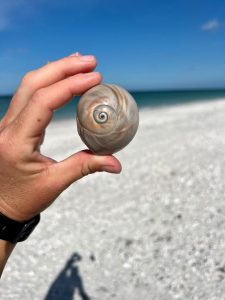 Sharkeye Shells (Neverita duplicata): The Sharkeye, also known as the Atlantic Moon Snail, is a type of gastropod mollusk found along the eastern coast of the United States. The Sharkeye shell is easily recognizable by its smooth, rounded, and slightly flattened appearance, often featuring a distinctive, deep umbilicus (navel-like depression). The shells are typically grayish to bluish or brownish in color, occasionally with darker spiral bands.
Sharkeye Shells (Neverita duplicata): The Sharkeye, also known as the Atlantic Moon Snail, is a type of gastropod mollusk found along the eastern coast of the United States. The Sharkeye shell is easily recognizable by its smooth, rounded, and slightly flattened appearance, often featuring a distinctive, deep umbilicus (navel-like depression). The shells are typically grayish to bluish or brownish in color, occasionally with darker spiral bands.
Tulips
Tulips – Banded and True (Fasciolaria tulipa & Tulipa sp.): Don’t be fooled by the name! These are not actual tulip flowers, but rather seashells belonging to the gastropod family. Both varieties resemble a closed tulip flower with a pointed spire and a flared opening.
-
Banded Tulip Shell (Fasciolaria tulipa): This is the more common of the two tulip shells found in Florida. They are medium to large in size, typically ranging from 4 to 9 inches in length. The Banded Tulip Shell has a light-colored background (often grayish or cream) with a distinctive brown band spiraling around the middle of the shell.
-
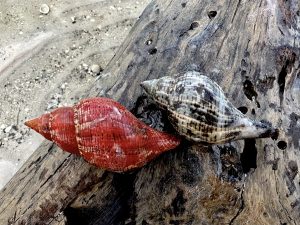 True Tulip Shell (Tulipa sp.): A rarer find compared to the Banded Tulip, the True Tulip Shell boasts a smoother,more elegant appearance. These shells tend to be smaller, usually reaching only 3 to 5 inches long. True Tulip Shells come in a wider variety of colors than their banded counterparts, including white, pink, and orange. They lack the prominent brown band and may have a more mottled or speckled pattern.
True Tulip Shell (Tulipa sp.): A rarer find compared to the Banded Tulip, the True Tulip Shell boasts a smoother,more elegant appearance. These shells tend to be smaller, usually reaching only 3 to 5 inches long. True Tulip Shells come in a wider variety of colors than their banded counterparts, including white, pink, and orange. They lack the prominent brown band and may have a more mottled or speckled pattern.
Turkey Wing Shells
The turkey wing (Arca zebra) is a bivalve shell named for its unique shape and coloration. It is brown and white, with alternating dark and light stripes. It is small, rarely more than four inches in length, and rectangular in shape.
Ethical Shelling
Responsible shelling ensures that our beaches remain pristine and abundant with marine life for future generations. Remember these key guidelines:
-
- Leave Live Shells: If you find a shell with a live animal inside, gently return it to the sea.
-
- Follow Local Regulations: Some areas have restrictions on the collection of certain shells. Always check local regulations before you collect.
-
- Practice “Leave No Trace”: Take only empty shells, and leave the beach as you found it. Avoid disturbing the natural environment.
Conclusion
Florida’s beaches are a treasure trove of beautiful seashells waiting to be discovered. Whether you’re exploring Sanibel Island, Marco Island, or the Ten Thousand Islands, this guide will help you identify and appreciate the stunning variety of seashells you encounter. Happy shelling!
Ready to discover the hidden treasures of Florida’s beaches? Book a shelling tour with Treasure Seekers Shell Tours today and let our expert guides show you the best spots for finding these beautiful shells. Visit our website to learn more and secure your adventure!
#FloridaShelling #SanibelIsland #MarcoIsland #SeashellIdentification #ShellingTours #EcoFriendlyShelling #TreasureSeekersShellTours
